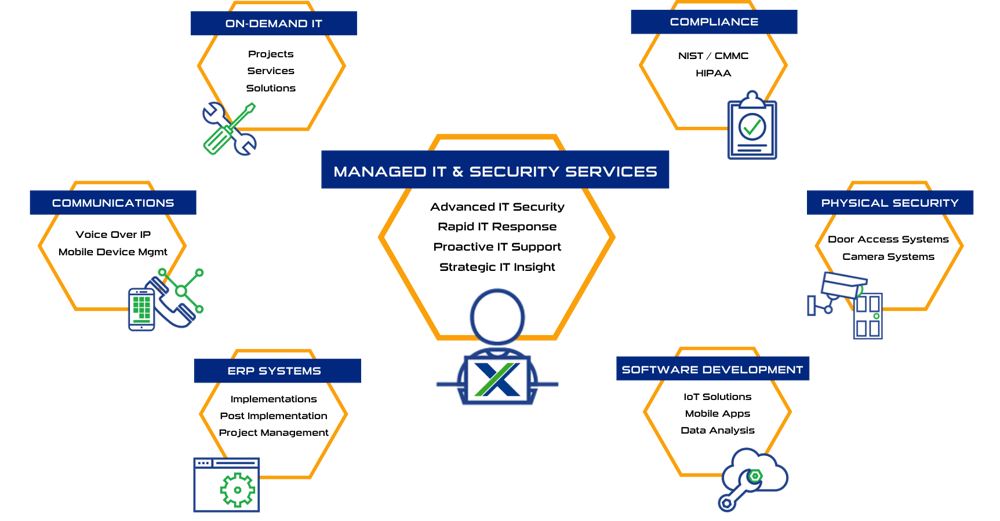What Could Digital IT Transformation Do For Your Business?

As an ambitious business owner, you're always looking for new ways to help your business develop, improve, and grow, no matter how successful it already is.
You'll also want to improve the experience for your customers. And of course, you'll be aware that your IT infrastructure plays a big part in this growth and the overall experience.
That works both ways. Sometimes it's that same infrastructure that can limit how your business evolves. If you're running older systems that don't fully meet your needs, growth can be held back.
This is where digital IT transformation comes in.
Maybe you’ve never heard that term before. Or perhaps the concept is new to you. Here’s a one line explanation:
Digital IT transformation is about using modern technology to create or modify business processes, culture, and customer experiences.
It involves a complete reassessment and overhaul of your technology, with the goal of improving the efficiency and delivery of your products or services.
We can make this easier with a few case studies of how big businesses you’ve definitely heard of, used digital IT transformation. Just because these are big names doesn’t mean it isn’t relevant to you... this is for all businesses, of all sizes.
Netflix
Are you old enough to remember when Netflix's business model was based on direct mail?
They’d mail their customers a DVD. Customers would watch it, post it back, then wait a few days for another DVD to arrive through their letterbox. Of course, Netflix led the way to the streaming world we enjoy today.
That was digital IT transformation. They used technology to flip their business model on its head.
This has not only improved customer experience (now you wait seconds instead of days for a movie), but it’s also increased customer loyalty too. As of March this year, Netflix has a market value of $168 billion.

Lego
Believe it or not, in 2004, Lego was on the brink of bankruptcy.

This pushed the company to start its digital IT transformation journey, which is still ongoing today.
First, Lego digitized its supply chain processes, which allowed it to gain more insight into production delays and manufacturing costs.
Then between 2008 and 2016 the company centralized its HR applications, moved to a digitized shop floor system, and streamlined its decision-making processes.
To improve customer experience, Lego added mobile apps, games, and even movies to its products.
The first Lego film generated an additional $467 million in revenue (off a production budget of $65 million).
Kodak
When you think of Kodak today, you think of a dead camera company.
As the digital revolution took hold at the start of the century, cameras evolved from using film to storing photos digitally.
Kodak held firm with film (despite inventing the first digital camera!) under the impression that launching a digital camera would cannibalize its existing business.
We now know that was not the case. Kodak’s failure to digitally transform at the right time led to the company losing a lot of money, and going bankrupt in 2012.
Eventually, after a big financial loss, Kodak took the step towards digital photography, but it was too late.

Of course, these are extreme cases and big famous businesses, but they highlight just what a difference embracing digital IT transformation (or failing to embrace it) can make to your business.
There are 4 main areas of transformation that you need to consider:
1. Process Transformation
This is most appropriate when a business needs a radical transformation. It can modernize your processes, integrate new technology, and save money, while still incorporating your core systems. Process transformation can result in the most drastic changes to your business.
Before you begin, and to help decide whether its the right step for you right now, you need to ask yourself what your goals are for transformation:

-
Do you need to upgrade your systems?
-
Will you need to bring in new technology?
-
Will you change your processes to a new structure?
It's really important to set baseline metrics when deciding on process transformation. These will help you understand if the transformation is a success. So, as well as setting new KPIs (Key performance indicators) you should also set baseline metrics based on your expectation of the new structure, and the typical results of your old structure. Including things like time, cost, errors, and downtime suffered. You should involve your team in this process. Ask for feedback on how your current system is working, it's benefits and drawbacks.
Find out how the people using the systems would make improvements, and how their jobs could be made simpler. What would they like to see in a new system? How can they see new processes improving their role and making them more productive? This kind of feedback can give you the most valuable insight into how your systems should be working to make the biggest improvement.
And before you embark on process transformation, you should create an ideal workflow path. This will help you identify the areas that you need to focus on first, and to really understand both the systems tasks that take place, and the human element too.
2. Business Model Transformation
It's really important to set baseline metrics when deciding on process transformation. These will help you understand if the transformation is a success. So, as well as setting new KPIs (Key performance indicators) you should also set baseline metrics based on your expectation of the new structure, and the typical results of your old structure. Including things like time, cost, errors, and downtime suffered. You should involve your team in this process. Ask for feedback on how your current system is working, it's benefits and drawbacks.
Find out how the people using the systems would make improvements, and how their jobs could be made simpler. What would they like to see in a new system? How can they see new processes improving their role and making them more productive? This kind of feedback can give you the most valuable insight into how your systems should be working to make the biggest improvement.
And before you embark on process transformation, you should create an ideal workflow path. This will help you identify the areas that you need to focus on first, and to really understand both the systems tasks that take place, and the human element too.
3. Domain Transformation
It's really important to set baseline metrics when deciding on process transformation. These will help you understand if the transformation is a success. So, as well as setting new KPIs (Key performance indicators) you should also set baseline metrics based on your expectation of the new structure, and the typical results of your old structure. Including things like time, cost, errors, and downtime suffered. You should involve your team in this process. Ask for feedback on how your current system is working, it's benefits and drawbacks.
Find out how the people using the systems would make improvements, and how their jobs could be made simpler. What would they like to see in a new system? How can they see new processes improving their role and making them more productive? This kind of feedback can give you the most valuable insight into how your systems should be working to make the biggest improvement.
And before you embark on process transformation, you should create an ideal workflow path. This will help you identify the areas that you need to focus on first, and to really understand both the systems tasks that take place, and the human element too.
4. Organizational Transformation
It's crucial that if your business spends time and money updating its technology and designing its processes and products, that its interval values and behaviors evolve to mirror this change, too. Failure to get buy-in from your people could result in the complete failure of your transformation, even if everything else is primed to work. Just a little resistance can mean adoption of your new technology is slower than it should be.
And you don't need us to point out that the result of this would be a loss of revenue, productivity, and potentially even your people. Make the time to clearly communicate your vision for transformation. Do this regularly. Involve your people in the processes, and ask for - and importantly, listen to - their feedback along the way. Everyone should understand the risk and why it's worth taking.
The Rules
Regardless of your sector or industry and your current infrastructure and systems, any digital IT transformation strategy has 3 very important rules:
Rule 1:
You must modernize your existing critical IT infrastructure if you want to increase efficiency and your management overheads.
Rule 2:
You must automate your IT processes if you want to reduce risk and accelerate the provisioning and deployment of applications. This includes automating the delivery and use of IT services.
Rule 3:
You must transform your IT processes and operations if you want to align your IT goals, your staff, and their roles.
Of course, this is a very brief overview of a process that can be extremely complex. Here’s a great quote on this, from transformation scientist George Westerman:
“When digital transformation is done right, it’s like a caterpillar turning into a butterfly, but when done wrong, all you have is a really fast caterpillar."
That means, without the right investment from you, digital IT transformation just won’t happen. You need to have the right systems in place, but if you don’t know how to use them properly, you haven’t really transformed anything.
Ready to talk about this for your business?
Let's arrange a no-obligation conversation to run through all the areas that will be most important.
Have Questions? Let's Chat!

Systems X provides IT solutions and strategic IT guidance with a human touch. Our purpose is to empower you to make better decisions with high-quality data and world-class service. Our creative thinking and purpose-driven solutions are the fundamental gears to guide the strategy that will connect your business with what’s next!!
Sales: (586) 884-7835
Service Desk: (586) 991-1050
Managed Services in Chesterfield, MI
50801 E. Russell Schmidt Blvd, Chesterfield, MI 48051
Managed IT Services in Detroit
400 Renaissance Center Suite 2600 - #2073, Detroit, MI 48243
Managed IT Services in Ann Arbor
2723 S State St Suite 150 - #1690, Ann Arbor, MI 48104
Managed IT Services in Cleveland
1300 Superior Ave #3413, Cleveland, OH 44114
DUNS No.: 79-009-7088
CAGE Code: 8YVR5
NAICS Codes: 541511, 541512, 541513, 541519, 517911, 611420
© 2025 Systems X Corporation